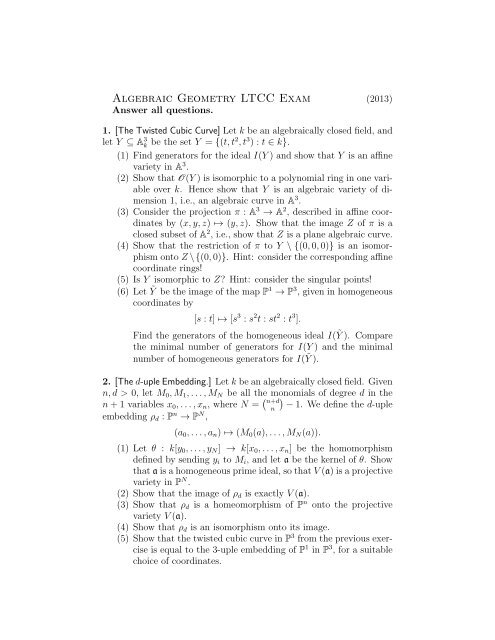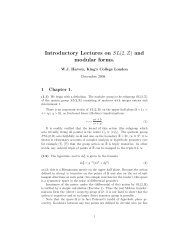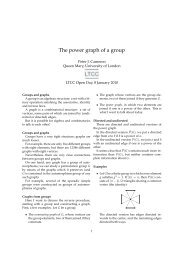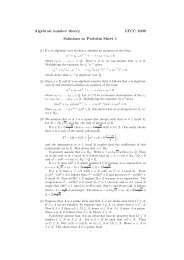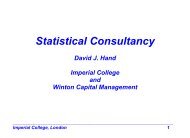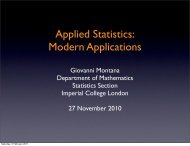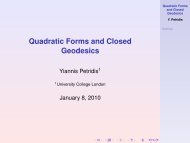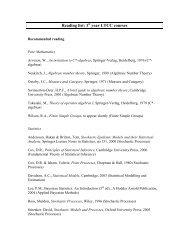Algebraic Geometry LTCC Exam
Algebraic Geometry LTCC Exam
Algebraic Geometry LTCC Exam
Create successful ePaper yourself
Turn your PDF publications into a flip-book with our unique Google optimized e-Paper software.
<strong>Algebraic</strong> <strong>Geometry</strong> <strong>LTCC</strong> <strong>Exam</strong> (2013)<br />
Answer all questions.<br />
1. [The Twisted Cubic Curve] Let k be an algebraically closed field, and<br />
let Y ⊆ A 3 k be the set Y = {(t, t2 , t 3 ) : t ∈ k}.<br />
(1) Find generators for the ideal I(Y ) and show that Y is an affine<br />
variety in A 3 .<br />
(2) Show that O(Y ) is isomorphic to a polynomial ring in one variable<br />
over k. Hence show that Y is an algebraic variety of dimension<br />
1, i.e., an algebraic curve in A 3 .<br />
(3) Consider the projection π : A 3 → A 2 , described in affine coordinates<br />
by (x, y, z) ↦→ (y, z). Show that the image Z of π is a<br />
closed subset of A 2 , i.e., show that Z is a plane algebraic curve.<br />
(4) Show that the restriction of π to Y \ {(0, 0, 0)} is an isomorphism<br />
onto Z \{(0, 0)}. Hint: consider the corresponding affine<br />
coordinate rings!<br />
(5) Is Y isomorphic to Z? Hint: consider the singular points!<br />
(6) Let Ỹ be the image of the map P1 → P 3 , given in homogeneous<br />
coordinates by<br />
[s : t] ↦→ [s 3 : s 2 t : st 2 : t 3 ].<br />
Find the generators of the homogeneous ideal I(Ỹ ). Compare<br />
the minimal number of generators for I(Y ) and the minimal<br />
number of homogeneous generators for I(Ỹ ).<br />
2. [The d-uple Embedding.] Let k be an algebraically closed field. Given<br />
n, d > 0, let M 0 , M 1 , . . . , M N be all the monomials of degree d in the<br />
n + 1 variables x 0 , . . . , x n , where N = ( )<br />
n+d<br />
n − 1. We define the d-uple<br />
embedding ρ d : P n → P N ,<br />
(a 0 , . . . , a n ) ↦→ (M 0 (a), . . . , M N (a)).<br />
(1) Let θ : k[y 0 , . . . , y N ] → k[x 0 , . . . , x n ] be the homomorphism<br />
defined by sending y i to M i , and let a be the kernel of θ. Show<br />
that a is a homogeneous prime ideal, so that V (a) is a projective<br />
variety in P N .<br />
(2) Show that the image of ρ d is exactly V (a).<br />
(3) Show that ρ d is a homeomorphism of P n onto the projective<br />
variety V (a).<br />
(4) Show that ρ d is an isomorphism onto its image.<br />
(5) Show that the twisted cubic curve in P 3 from the previous exercise<br />
is equal to the 3-uple embedding of P 1 in P 3 , for a suitable<br />
choice of coordinates.
3.<br />
(1) [Zeta function of a Pell conic] Let X be the Pell conic<br />
V (x 2 − ∆y 2 − 4) ⊆ A 2 k,<br />
for ∆ ∈ k \ {0}, and k = F q , for q a power of an odd prime.<br />
Compute the zeta function of X over k. Hint:<br />
(a) Note that P = (2, 0) is always a point on X. Show that X<br />
is a non-singular curve.<br />
(b) In the case when ∆ is a square in k, X is isomorphic to the<br />
hyperbola V (xy − 1) so it is easy to count its points over<br />
finite fields.<br />
(c) In the more interesting case when ∆ is not a square in k,<br />
draw lines of varying slopes through P and compute the<br />
other intersection with X and use this ‘projection from P ’<br />
to count the points over k. Note that if ∆ is not a square<br />
in F q , it will be a square in F q 2r and it will not be a square<br />
in F q 2r+1.<br />
(2) [Extension of scalars for zeta] Prove the Extension of scalars<br />
Lemma for the zeta function. Let X be a variety defined over a<br />
finite field F q , and let X × Fq F q r be the same variety considered<br />
over the extension field F q r. Then<br />
Z(X × Fq F q r/F q r, T r ) = ∏<br />
Z(X/F q , ξT ).<br />
ξ r =1<br />
The product on the right is taken over the r-th roots of unity.<br />
(Dr. Ivan Tomašić, QMUL)


